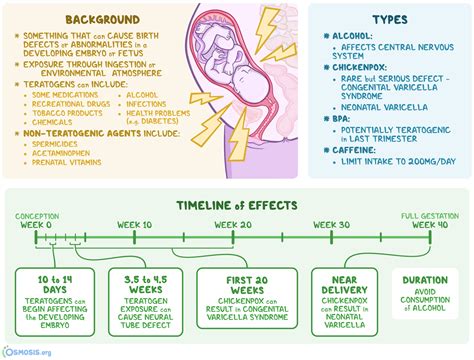teratogel|Iba pa : Baguio Teratogens are substances that cause congenital disorders in a developing embryo or fetus. A teratogen is anything a person is exposed to or ingests during pregnancy that’s known to cause fetal abnormalities. Drugs, medicine, chemicals, certain infections and toxic substances are examples . Tingnan ang higit pa Oportunidad crescimentoPK OI Live BREGRAS DO PK QUE VOCÊ PRECISA SABEROportunidade de crescimento. PK Ofi Live B. PK O1 Live B.

teratogel,Teratogens are substances that cause congenital disorders in a developing embryo or fetus. A teratogen is anything a person is exposed to or ingests during pregnancy that’s known to cause fetal abnormalities. Drugs, medicine, chemicals, certain infections and toxic substances are examples . Tingnan ang higit paFetal exposure to teratogens accounts for about 4% to 5% of congenital disorders. Studies have also shown that exposure to teratogens affects . Tingnan ang higit paTeratogens are substances that can harm the fetus during pregnancy. Studies have shown that teratogens cause congenital disorders and increase the . Tingnan ang higit paExposure to teratogens is harmful no matter what point you’re at in pregnancy. However, the risk is slightly higher during the first eight weeks of . Tingnan ang higit paTeratogens cause many known congenital disorders. Some of the most common abnormalities are: 1. Brain or spinal cord issues . Tingnan ang higit pa

This article explains what a teratogen is using numerous examples of teratogens, including drugs, infections, physical agents, environmental toxins, and maternal health conditions. It also discusses . A teratogen is a substance that can cause abnormalities or birth defects in a developing fetus. Common teratogens include some medications, recreational drugs, tobacco . A teratogen is anything an individual is exposed to during pregnancy that causes an anomaly or malformation in the fetus. A teratogen can be a drug, .
What is a teratogen? A teratogen (ter-AT-uh-jen) is something that can cause or raise the risk for a birth defect in a baby. They are things that a mother may be exposed to .
A teratogen is any agent that can cause abnormal fetal development and birth defects. Learn how to spot teratogens and avoid teratogenic birth defects. A teratogen is any agent that causes an abnormality following fetal exposure during pregnancy. Teratogens are usually discovered after an increased .
Teratogen: an environmental factor that causes a permanent structural or functional abnormality, growth restriction, or death of the embryo or fetus; Effects .
Iba paWhat is a teratogen? A teratogen is an agent, which can cause a birth defect. It is usually something in the environment that the mother may be exposed to during her pregnancy. A teratogen is a compound that permanently deforms the function or structure of a developing embryo or fetus in utero. In general, the degree of .
teratogelTeratology is the study of abnormalities of physiological development in organisms during their life span. It is a sub-discipline in medical genetics which focuses on the classification of congenital abnormalities in dysmorphology caused by teratogens. Teratogens are substances that may cause non-heritable birth defects via a toxic effect on an .
Teratogen virkning kan deles i fysiske agens (ioniserende stråling), kjemiske stoffer (legemidler som thalidomid, hormoner), infeksjoner (røde hunder, syfilis, influensa, kusma, zikafeber) og underernæring (vitaminmangel, proteinmangel).Virkningen av et teratogen kan være meget spesifikk, det vil si bare én misdannelse opptrer, og bare én bestemt .Teratogen je tvar ili supstanca koja može dovesti do oštećenja ploda (nerođenog djeteta). Što je teratogenost? Teratogeni lijek mora stvoriti karakteristične malformacije na plodu. Teratogeni period dešava se u vrlo uskom razdoblju .

Una vez que el óvulo fertilizado penetra en el útero, se establece el aporte de sangre entre la madre y el embrión. En otras palabras, si hay algo en la sangre de la madre, a partir de ahora puede pasar al feto en desarrollo. Se cree que los teratógenos pueden afectar al feto aproximadamente entre 10 y 14 días después de la concepción.Experts believe that teratogens can begin affecting a baby growing in the womb about 10 to14 days after conception. Conception is when a woman’s egg is fertilized by a man’s sperm. After conception, it takes about 6 to 9 days for the egg to implant in the uterus. Once the fertilized egg is attached to the uterus, the mother and the embryo .
Teratogenność (dosłownie potworotwórczość od teratos – potwór) – właściwość teratogenów powodująca wady (potworności) w rozwoju płodu (mają ją np. promieniowanie, wirusy, ksenobiotyki, niektóre lekarstwa ). Działanie teratogenne to działanie toksyczne substancji na zarodek lub płód (śmierć zarodka, zaburzenia .One teratogen that affects the central nervous system is alcohol. Alcohol, at any time during the pregnancy, has the potential to cause birth defects and health problems in the baby, since the central nervous system is sensitive to teratogens the entire nine months of gestation. This is why alcohol consumption should be avoided in its entirety .Czynnik teratogenny a. teratogen (od teratos, potwór) – czynnik pochodzący ze środowiska zewnętrznego, działający na organizm w okresie jego rozwoju wewnątrzłonowego, wywołujący u niego odchylenia przekraczające granicę osobniczych zmienności fenotypu bądź defektów czynności metabolicznych, tj. wady wrodzone [1] .
teratogel|Iba pa
PH0 · what does teratogenic mean
PH1 · teratogenic drugs
PH2 · teratogene beispiele
PH3 · teratogen wikipedia
PH4 · teratogen examples psychology
PH5 · teratogen deutsch
PH6 · teratogen definition
PH7 · teratogen bedeutung
PH8 · Iba pa